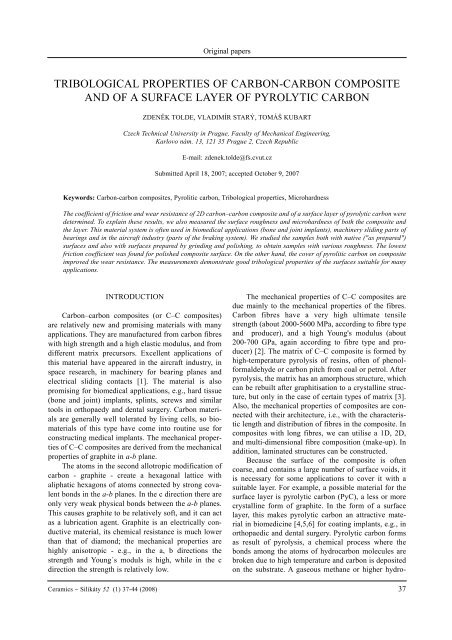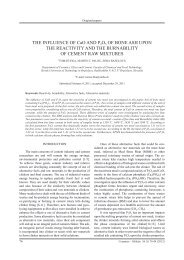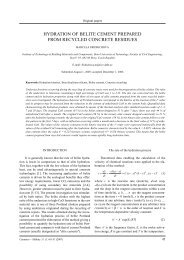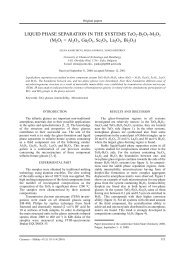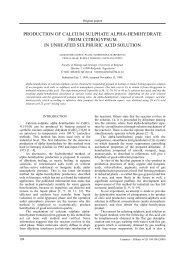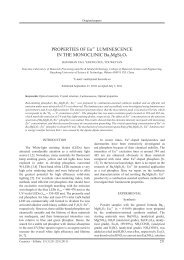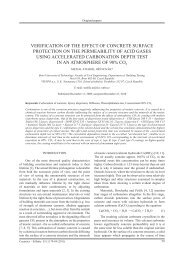TRIBOLOGICAL PROPERTIES OF CARBON ... - Ceramics-Silikaty
TRIBOLOGICAL PROPERTIES OF CARBON ... - Ceramics-Silikaty
TRIBOLOGICAL PROPERTIES OF CARBON ... - Ceramics-Silikaty
Create successful ePaper yourself
Turn your PDF publications into a flip-book with our unique Google optimized e-Paper software.
INTRODUCTION<br />
Carbon–carbon composites (or C–C composites)<br />
are relatively new and promising materials with many<br />
applications. They are manufactured from carbon fibres<br />
with high strength and a high elastic modulus, and from<br />
different matrix precursors. Excellent applications of<br />
this material have appeared in the aircraft industry, in<br />
space research, in machinery for bearing planes and<br />
electrical sliding contacts [1]. The material is also<br />
promising for biomedical applications, e.g., hard tissue<br />
(bone and joint) implants, splints, screws and similar<br />
tools in orthopaedy and dental surgery. Carbon materials<br />
are generally well tolerated by living cells, so biomaterials<br />
of this type have come into routine use for<br />
constructing medical implants. The mechanical properties<br />
of C–C composites are derived from the mechanical<br />
properties of graphite in a-b plane.<br />
The atoms in the second allotropic modification of<br />
carbon - graphite - create a hexagonal lattice with<br />
aliphatic hexagons of atoms connected by strong covalent<br />
bonds in the a-b planes. In the c direction there are<br />
only very weak physical bonds between the a-b planes.<br />
This causes graphite to be relatively soft, and it can act<br />
as a lubrication agent. Graphite is an electrically conductive<br />
material, its chemical resistance is much lower<br />
than that of diamond; the mechanical properties are<br />
highly anisotropic - e.g., in the a, b directions the<br />
strength and Young´s moduls is high, while in the c<br />
direction the strength is relatively low.<br />
Original papers<br />
<strong>TRIBOLOGICAL</strong> <strong>PROPERTIES</strong> <strong>OF</strong> <strong>CARBON</strong>-<strong>CARBON</strong> COMPOSITE<br />
AND <strong>OF</strong> A SURFACE LAYER <strong>OF</strong> PYROLYTIC <strong>CARBON</strong><br />
ZDENÌK TOLDE, VLADIMÍR STARÝ, TOMÁŠ KUBART<br />
Czech Technical University in Prague, Faculty of Mechanical Engineering,<br />
Karlovo nám. 13, 121 35 Prague 2, Czech Republic<br />
E-mail: zdenek.tolde@fs.cvut.cz<br />
Submitted April 18, 2007; accepted October 9, 2007<br />
Keywords: Carbon-carbon composites, Pyrolitic carbon, Tribological properties, Microhardness<br />
The coefficient of friction and wear resistance of 2D carbon–carbon composite and of a surface layer of pyrolytic carbon were<br />
determined. To explain these results, we also measured the surface roughness and microhardness of both the composite and<br />
the layer. This material system is often used in biomedical applications (bone and joint implants), machinery sliding parts of<br />
bearings and in the aircraft industry (parts of the braking system). We studied the samples both with native ("as prepared")<br />
surfaces and also with surfaces prepared by grinding and polishing, to obtain samples with various roughness. The lowest<br />
friction coefficient was found for polished composite surface. On the other hand, the cover of pyrolitic carbon on composite<br />
improved the wear resistance. The measurements demonstrate good tribological properties of the surfaces suitable for many<br />
applications.<br />
The mechanical properties of C–C composites are<br />
due mainly to the mechanical properties of the fibres.<br />
Carbon fibres have a very high ultimate tensile<br />
strength (about 2000-5600 MPa, according to fibre type<br />
and producer), and a high Young's modulus (about<br />
200-700 GPa, again according to fibre type and producer)<br />
[2]. The matrix of C–C composite is formed by<br />
high-temperature pyrolysis of resins, often of phenolformaldehyde<br />
or carbon pitch from coal or petrol. After<br />
pyrolysis, the matrix has an amorphous structure, which<br />
can be rebuilt after graphitisation to a crystalline structure,<br />
but only in the case of certain types of matrix [3].<br />
Also, the mechanical properties of composites are connected<br />
with their architecture, i.e., with the characteristic<br />
length and distribution of fibres in the composite. In<br />
composites with long fibres, we can utilise a 1D, 2D,<br />
and multi-dimensional fibre composition (make-up). In<br />
addition, laminated structures can be constructed.<br />
Because the surface of the composite is often<br />
coarse, and contains a large number of surface voids, it<br />
is necessary for some applications to cover it with a<br />
suitable layer. For example, a possible material for the<br />
surface layer is pyrolytic carbon (PyC), a less or more<br />
crystalline form of graphite. In the form of a surface<br />
layer, this makes pyrolytic carbon an attractive material<br />
in biomedicine [4,5,6] for coating implants, e.g., in<br />
orthopaedic and dental surgery. Pyrolytic carbon forms<br />
as result of pyrolysis, a chemical process where the<br />
bonds among the atoms of hydrocarbon molecules are<br />
broken due to high temperature and carbon is deposited<br />
on the substrate. A gaseous methane or higher hydro-<br />
<strong>Ceramics</strong> − Silikáty 52 (1) 37-44 (2008) 37
carbons at low pressure are usually used. The process<br />
temperature is about 1200-1300°C for amorphous low<br />
temperature pyrolytic carbon (LTI, low temperature<br />
isotropic), up to 2200°C for partially crystalline<br />
pyrolytic carbon, and over 2200 C for pyrolytic graphite<br />
(recomendation of IUPAC,1995).<br />
Tribological examinations determine the friction<br />
coefficient for a combination of two materials classified<br />
as the substrate (e.g., in the form of disc) and body with<br />
specific properties and dimensions ("pin, corpuscle,<br />
ball, roller"), in a given environment. The action is<br />
usually realized by the movement of a ball or a roller<br />
of one material on the plane plate of another studied<br />
material. In the pin-on-disc analyses (ball on a plane<br />
plate) the corpuscle in the form of a roller or a nonrotating<br />
ball is placed on a surface of the specimens<br />
with the shape of a flat disc. The "pin" is loaded in<br />
advance by a defined force at a defined distance from<br />
the centre of the sample. At friction, the tangential force<br />
is caused by shear strength due to the asperities and<br />
their microhardness, which appears at the contact areas<br />
of two bodies. The axial tension loaded on the corpuscle<br />
arise the plastic deformation of both surfaces. In<br />
both cases of friction (adhesive and abrasive) the elimination<br />
of hills and transfer of material will depend on<br />
the ratio of tangential and axial stress tensions. In the<br />
case of dry friction, the test results usually depend on<br />
the following parameters: loading power, size of the<br />
contiguous surface, speed, temperature of the couple,<br />
environmental atmosphere, and, last but not least, the<br />
mechanical and physical properties of the materials of<br />
the sample and the corpuscle [7], mainly on the state<br />
and quality of their surfaces.<br />
The values of the friction coefficient and the size of<br />
the abrasion volume are clearly connected with the<br />
roughness of the contiguous surface. Accordingly, it is<br />
necessary to observe the individual surface roughness<br />
and surface state characteristics of the samples, from the<br />
point of view of appearance and frequency of failures,<br />
including breaches. It has been demonstrated [8] that<br />
the value of the friction coefficient, and its course, i.e.,<br />
the change during the examination or in running, and<br />
the wear and abrasion modes of the cutting marks depend<br />
on surface roughness. When the surface roughness<br />
is high, then intensive corpuscle jumping or "skipping"<br />
appears and, as a result, there is an extensive scatter of<br />
the measured friction coefficient values. The salient<br />
unevenness is gradually plastically deformed, and in<br />
this way the scattering of the measured values should<br />
decrease.<br />
Unfortunately, there is very little available information<br />
on the tribological properties of pyrolytic carbon.<br />
Around 1995, LTI pyrolytic carbon was intensively<br />
studied as a material for leaflets of heart valves from the<br />
point of view of wear [9,10]. The tribological properties<br />
of some other types of carbon compounds, mainly in the<br />
Tolde Z., Starý V., Kubart T.<br />
form of thin films, were also studied. Most of the available<br />
information is about carbon in the form of graphite<br />
for applications in electroindustry. In [11], the pin-ondisc<br />
measurements coefficient of friction was 0.02-0.1<br />
for a graphite pin/polycrystalline electrographite couple,<br />
at load 4N and sliding speed 0.03-0.05 m/s. It is<br />
supposed that abrasive wear creates the dangling bonds,<br />
located on the edge sites that lead to bad friction properties.<br />
Water vapour and oxygen passivate these bonds.<br />
Argon or helium decreases the friction coefficient much<br />
more, because their atoms insert themselves between<br />
the hexagonal planes of the graphite crystallites and<br />
separate them by intercalation. The cleavage strain<br />
exceeds the bonding strength between the layers, and<br />
the material can exhibit good friction properties.<br />
According to [12], the high orientation of surface crystallites<br />
obtained in the presence of water vapour during<br />
sliding leads to a pronounced decrease in the friction<br />
coefficient, and also in the wear rate.<br />
The tribological properties of pyrolytic carbon<br />
were also studied in our laboratory [13]. In this work,<br />
the friction coefficient and wear of polished C–C composite<br />
and of PyC on both unpolished and polished C–C<br />
composite were measured using a rotating cylinder<br />
on plate (HEF tribometer, France). The coefficient of<br />
friction depends strongly on the load between 40 and<br />
250 N. For polished samples with medium starting<br />
roughness a plateau was observed at approximately<br />
40-100 N. This non-monotonic growth of the friction<br />
coefficient was assumed to be due to optimal conditions<br />
of graphite debris spreading on the surface of the<br />
sample. The highest friction coefficient appeared for<br />
the sample with the lowest roughness. In the case of<br />
polished C–C composite, no stable state (plateau)<br />
appeared.<br />
Hardness is one of the basic parameters characterizing<br />
the mechanical properties of a material and also<br />
its friction and wear properties. It is known, that the<br />
volume of the worn down material (debris) is proportional<br />
not only to the load and the length of shear path,<br />
but also it should be inversely proportional to the hardness<br />
of the worn down material [14,15]. The influence<br />
of roughness on friction and wear for a diamond<br />
film/sapphire couple was studied in [16]. The friction<br />
and wear properties of thin films of polycrystalline<br />
diamond depend on both the counterface material and<br />
the properties of the diamond layer. The roughness of<br />
the diamond is critical, because it controls the amount<br />
of abrasive damage to the counterface. Also the tribological<br />
properties of other carbon compounds mainly<br />
DLC (diamond like carbon) were studied [6].<br />
The purpose of our work was to define the tribological<br />
properties of C–C composites and their change<br />
due to the layer of pyrolitic carbon and, moreover, to<br />
find the influnce of mechanical grinding of surface on<br />
friction and wear.<br />
38 <strong>Ceramics</strong> − Silikáty 52 (1) 37-44 (2008)
Tribological properties of carbon–carbon composite and of a surface layer of pyrolytic carbon<br />
EXPERIMENTAL<br />
Specimens of 2D C–C composites were manufactured<br />
at the Institute of Rock Structure and Mechanics<br />
of AS CR (Prague, Czech Republic), by heat treatment<br />
(carbonisation) of "green" composites produced by<br />
moulding carbon fabric layers soaked with an ethanol<br />
solution of Umaform-LE phenolformaldehyde resin.<br />
A plain weave fabric made of Torayca T800 fibres was<br />
employed as reinforcement.<br />
The square mouldings (120×120 mm) consisted of<br />
several (usually 8) layers, according to the required<br />
specimen thickness. Curing at 125°C took place in a<br />
heated mould under uni-axial pressure of 1 MPa. For<br />
tribological measurements, the cured plates were cut<br />
using a diamond saw into samples of 13.0×13.0 mm and<br />
carbonised at 1000°C in nitrogen, which converted the<br />
cured polymer matrix to a carbon material similar to<br />
glass-like carbon. The C–C composites produced in this<br />
way revealed remarkable open porosity (about 20-25 %<br />
as measured by water penetration) because certain<br />
shrinkage and mass loss (up to 30 %) took place during<br />
pyrolysis. The specimens were therefore twice impregnated<br />
with the resin and re-carbonised, which reduced the<br />
open porosity to ≈15 %. All specimens were ultimately<br />
graphitised, i.e., heat treated in argon at 2200°C [3].<br />
The pyrolytic carbon layers were prepared by<br />
decomposition of butane in a vacuum at a pressure of<br />
4 Pa and a temperature of 1900°C, for 300-400 minutes.<br />
The layer thickness was between 0.25-0.7 mm. For<br />
some types of samples the composite surface was<br />
ground by metallographical paper till 4000 grade. This<br />
process also enables subsequent grinding and polishing<br />
of the pyrolytic carbon layer, which was not performed<br />
in the present study. Light microscopy showed the<br />
columnar growth of the layer; and imperfections<br />
approximately parallel with the layer surface can also<br />
be seen [3]. X-ray diffraction provides a better crystallographic<br />
quality of the pyrolytic carbon layer than<br />
of the C–C composite (narrower peak 002 and 004),<br />
although different from the X-ray pattern of real<br />
graphite.<br />
The mechanical properties of pyrolytic carbon were<br />
measured many times, but unfortunately the values are<br />
very widely spread due to the different conditions of<br />
preparation. The diversity of, for example, Young's<br />
modulus values is due not only to the heat treatment<br />
temperature, but also to type of precursor, pressure of<br />
gas etc. Most information on the mechanical properties<br />
of hard films is obtained by micro- or nanoindentation<br />
techniques. Apart from the hardness, which will be<br />
mentioned below, the modulus of elasticity value is<br />
also measured by nanoindentation technique. The<br />
referred value was E = 7.5 GPa for pyrolytic graphite<br />
and E = 2.26-10.7 GPa for isotropic carbon [6,7].<br />
In this way, four sets of samples were prepared,<br />
with various states of the surface, which are summarized<br />
in Table 1. SET I and SET II come under C–C<br />
(composite) samples, while SET III and SET IV come<br />
under PyC/C–C samples.<br />
Table 1. Basic definition of the samples sets.<br />
SET I (C–C)<br />
SET II (C–C)<br />
SET III (PyC/C–C)<br />
SET IV (PyC/C–C)<br />
Basically, we measured the coefficient of friction<br />
and the wear during the tribometric test. The measurement<br />
of the friction coefficient was carried out directly,<br />
using a standard pin-on-disc tribometer, CSEM Instruments,<br />
Switzerland. Schematically, the diagram of our<br />
measurement system is in Figure 1. (abrasion ball on a<br />
plane plate). Next, the wear was evaluated from the<br />
shape of the spherical corpuscle ("pin") path (cutting<br />
marks) on the sample. The cross-section of the cutting<br />
marks on the sample surface is defined using standards<br />
[17-19].<br />
as:<br />
The samples were without surface treatment,<br />
and the surface state is given by<br />
the preparation technology for the composite.<br />
The surface of the composite was<br />
ground by metallographic paper (Waterproof<br />
Silicon Carbide Paper), sequentially<br />
by grade 500, 800, 1000, 4000,<br />
speed 150 rpm.<br />
Samples without surface treatment<br />
were covered by a layer of pyrolytic<br />
carbon about 0.6 mm in thickness.<br />
Samples ground by metallographic<br />
paper (finally 4000 grade) were covered<br />
by a layer of pyrolytic carbon about<br />
0.6 mm in thickness.<br />
Figure 1. Diagram of an abrasion ball on a plane plate.<br />
Here, the area of the path cross-section is defined<br />
S0 = [r 2 ·sin -1 (d/2r) - (d/4)(4r 2 - d 2 ) 1/2 ] (mm 2 ) (1)<br />
where d is wear track width, r is ball radius.<br />
<strong>Ceramics</strong> − Silikáty 52 (1) 37-44 (2008) 39
Full volume of sphere path is given as:<br />
V0 = 2πR[r 2 ·sin -1 (d/2r) - (d/4)(4r 2 - d 2 ) 1/2 ] (mm 3 ) (2)<br />
where R is wear track radius.<br />
The wear volume normalised for full path and<br />
working force (specific wear) can be written as:<br />
(mm3 V0<br />
w<br />
/Nm) (3)<br />
2 =<br />
l • F<br />
l being the full path of sphere [m], F applied force [N].<br />
During the wear test, we used a constant load of<br />
15 N, the rotation rate was 150 rpm, the radius of the<br />
path was 2 mm, the velocity of sliding was 0.04 m/s,<br />
and the test was stopped after 4000 revolutions. The<br />
path radius r and the number of revolutions n define the<br />
full path and the time needed for the test. In this way,<br />
the full path of the pin on the sample was about 38 m.<br />
ÈSN 19436 tool steel (ISO 41 9436) with hardness<br />
62 HRC and surface roughness with Ra = 0.01-0.013 µm<br />
was used for the spherical pin, the diameter of the pin<br />
being 6 mm.<br />
The full test schedule was as follows:<br />
1. ultrasonic cleaning;<br />
2. measurement of the sample roughness by profilometer<br />
(TALYSURF 6,Taylor-Hobson Ltd., U.K.);<br />
Figure 2. Detail cutting mark of the pin path.<br />
Tolde Z., Starý V., Kubart T.<br />
3. tribometric test;<br />
4. ultrasonic cleaning;<br />
5. measurement of path profiles, using the TALYSURF<br />
6 profilometer. Measurement proceeded parallel with<br />
the composite fibres, and the shape of the surface was<br />
graphically written in a suitable and known scale. In<br />
this profile we estimated the start and end of the profile<br />
of the cutting mark of the pin path. Then its width<br />
and depth were manually measured.<br />
6. test of microhardness.<br />
After the test, the surface of the samples and of the<br />
spherical pin were observed in SEM (Figure 2). Also,<br />
the Vickers microhardness was measured using the<br />
microhardness tester (SHIMADZU, Japan, HMV - 2).<br />
Examples of the measurement output records are shown<br />
in Figure 3.<br />
RESULTS<br />
The experimental results of the roughness measurements<br />
are given in Table 2. Parameters Ra (mean roughness),<br />
Rtm (maximum roughness value), Rq (root mean<br />
square - parameter corresponding to Ra) and S (mean<br />
spacing of the measured adjacent local peaks) are presented<br />
in Table 2. Tables 3 and 4 summarize the results<br />
of measurements of the friction coefficient and of<br />
the wear of C–C and PyC/C–C samples, respectively.<br />
Table 2. Initial values of the roughness parameters; average values of three measurement.<br />
SET Ra Standard Rtm Standard Rq Standard S Standard<br />
No. (µm) deviation (µm) deviation (µm) deviation (µm) deviation<br />
I 7.17 0.28 38.00 2.16 9.77 0.16 49 13<br />
II 5.40 0.86 29.00 4.08 8.57 0.51 180 65<br />
III 8.03 0.41 37.33 2.86 10.93 0.86 70 32<br />
IV 3.10 0.32 19.33 2.35 5.23 0.66 81 22<br />
0.17<br />
0.16<br />
0.15<br />
0.14<br />
0.13<br />
0.12<br />
0.11<br />
0.10<br />
0.09<br />
0.08<br />
0.07<br />
0.06<br />
0 500 1000 1500 2000 2500 3000 3500 4000<br />
Cycles<br />
40 <strong>Ceramics</strong> − Silikáty 52 (1) 37-44 (2008)<br />
Friction coefficient<br />
Set IV<br />
Set I<br />
Set III<br />
Set II<br />
Figure 3. Time dependence of the average values of the friction<br />
coefficient from three measurements for each set of samples.
Tribological properties of carbon–carbon composite and of a surface layer of pyrolytic carbon<br />
We characterised the friction coefficient µ by 1) the<br />
mean value in the test, 2) the value after 250 revolutions<br />
of the disc, and 3) the final value at the end of the test.<br />
All these values were automatically recorded by the tribometer.<br />
The wear was characterised by the cross-section<br />
of the wear path S0 (1), wear volume V0 (2), and<br />
specific wear w2 in units (mm 3 /Nm) (3).<br />
Figures 4 and 5 show the load-depth dependencies<br />
when measuring microhardness (load 106 mN). The<br />
dashed line is the supposed dependence of elastic deformation<br />
at deloading, used for calculating of the elastic<br />
modulus. The microhardness was measured only for<br />
two sets of samples, SET II and SET IV, respectively,<br />
due to the problems in the case of rough surfaces of<br />
the unground samples. For the samples of SET II, the<br />
measurement was carried out at protruding fibres, hardness<br />
of matrix was not measured. The load-depth<br />
dependencies show very different behaviour of the two<br />
materials. Table 5 gives the average values of three<br />
microhardness measurements of samples of SET II<br />
and IV. Two values of hardness are calculated from the<br />
measurements using the evaluation value, firstly the<br />
so-called dynamical hardness, measured using a loaded<br />
indentor, i.e., connecting the elastic and plastic deformation<br />
together, and corrected hardness, measured after<br />
unloading, i.e., including only plastic deformation. This<br />
corrected hardness is obtained at the standard hardness<br />
measurement.<br />
Table 3. Friction coefficient µ of C–C and PyC/C–C samples; average values of three measurements.<br />
µ<br />
SET Mean in Standard After 250 Standard Maximum in Standard<br />
No. the test deviation rotations deviation the test deviation<br />
I 0.116 0.006 0.123 0.010 0.113 0.008<br />
II 0.106 0.013 0.111 0.004 0.106 0.016<br />
III 0.134 0.009 0.132 0.014 0.146 0.006<br />
IV 0.132 0.010 0.113 0.008 0.131 0.011<br />
Table 4. Measured wear values; average values of three measurements.<br />
SET Cross-section of wear Standard deviation Wear volume Standard deviation Specific wear Standard<br />
No. path S0 (10 -2 mm 2 ) (10 -2 mm 2 ) V0 (10 -2 mm 3 ) (10 -2 mm 2 ) w2 (mm 3 /Nm) deviation<br />
I 0.64 0.04 5.05 0.26 107.3E-09 5.77E-09<br />
II 0.69 0.15 5.47 0.52 116.5E-09 2.18E-09<br />
III 0.46 0.09 3.67 0.75 78.0E-09 7.96E-09<br />
IV 0.45 0.15 3.58 0.91 72.5E-09 8.76E-09<br />
Table 5. Average values of selected hardness parameters of three measurements for samples of SETS II and IV.<br />
SET Load Elastic Plastic Maximum Dynamical Corrected Young's Modulus<br />
No. (mN) depth (µm) depth (µm) depth(µm) hardness (µm) Hardness (MPa) (µm)<br />
II 106 2.72 2.29 5.02 154 798 2.324<br />
IV 106 1.05 1.49 2.55 586 1687 7.91<br />
Load (gf)<br />
10.0<br />
8.0<br />
6.0<br />
4.0<br />
2.0<br />
0.0<br />
0.0 1.0<br />
2.0<br />
3.0 4.0 5.0 6.0<br />
Depth (µm)<br />
Figure 4. Load-depth dependence when measuring microhardness<br />
(SET II, load 106 mN).<br />
<strong>Ceramics</strong> − Silikáty 52 (1) 37-44 (2008) 41<br />
Load (gf)<br />
10.0<br />
8.0<br />
6.0<br />
4.0<br />
2.0<br />
0.0<br />
0.0 0.5<br />
1.0<br />
1.5 2.0 2.5 3.0<br />
Depth (µm)<br />
Figure 5. Load-depth dependence when measuring microhardness<br />
(SET IV, load 106 mN).
DISCUSSION<br />
When measuring the time dependence of the friction<br />
coefficient, we must decide what is the importance<br />
of the sequential values and what values are the most<br />
characteristic for various samples. The average values<br />
of the friction coefficient are important, even though<br />
they do not characterize the time changes of the friction<br />
coefficient fully. We suppose that the most important<br />
friction coefficient value is the value after 250 turns.<br />
This value is taken after running-in, i.e., after grinding<br />
out most of the nodes and protrusions, and reaching<br />
some stable state. Thus, this value of friction coefficient<br />
is discussed in the following text. The lowest value of<br />
the friction coefficient is for the ground C–C composite,<br />
and the value is almost the same for unground C–C<br />
composite with a PyC layer. The differences between<br />
these values show that for the C–C composite a<br />
decrease in roughness decreases the friction coefficient<br />
by about 10 %, while in the case of the PyC layer a<br />
decrease in roughness increases the friction coefficient<br />
by about 30 %. The latter comparison is statistically<br />
significant, while the significance of the former is relatively<br />
low; the statistical significance was checked<br />
using the standard formula for Student test at significance<br />
level α = 0.05 [20].<br />
The data for friction and wear of PyC are very rare<br />
in literature. Our results agree generally with values for<br />
various DLC films in [21, 22]. In [21] amorphous<br />
hydrogenated carbon films were prepared using 5%<br />
C2H2, 95% H2. The hardness and roughness of those<br />
films was not given. Under vacuum conditions, the<br />
value of friction coefficient was 0.12 at the start of test<br />
which agree with our results (in air). After hundred<br />
turns it decreases to about 0.08 due to roughness effect.<br />
Again it agrees with our results (sets I, II, IV), even<br />
though the decrease of friction coefficient in our measurement<br />
was slightly lower (in average for about 0.01).<br />
The same shape of time dependence of friction as<br />
for our measurement (set III) was found in [2] for<br />
fretting wear. Fretting wear occurs when two contacting<br />
materials undergo a relative oscillating displacement<br />
(stroke 0.1 to 200 µm), as can be the case for machine<br />
parts. At the RF plasma-produced DLC coating (roughness<br />
Ra 0.17 µm, E-modulus (58 ± 5) GPa and hardness<br />
5 ± 1 GPa, with counterpart created by a polished<br />
corundum ball of 10 mm diameter), the wear rate was<br />
1.6×10 -7 mm 3 /Nm, which is comparable with our results.<br />
The increasing of fric-tion coefficient at set III is similar<br />
to a behaviour which given in [21], but the reason is<br />
unclear till now.<br />
The differences in the friction coefficient between<br />
the C–C and PyC surfaces are low for higher roughness<br />
and much more pronounced for lower roughness. This<br />
finding signalises the possibility of an increasing<br />
Tolde Z., Starý V., Kubart T.<br />
dependence of friction coefficient on material type in<br />
the case of a flatter surface, perhaps due to better contact<br />
between pin and surface materials when there is<br />
lower roughness. At higher roughness, the contact<br />
between the two materials during mutual movement is<br />
much interrupted by "skipping" of the pin on the surface<br />
asperities.<br />
As usual, the movement of the pin on a more or less<br />
rough surface causes slight instabilities of the friction<br />
coefficient, and this appears as measurement noise. The<br />
general time dependence of µ shows that for sets I, III<br />
and IV after a rapid increase the values stabilised (I and<br />
IV) or increased slowly (III). Only set II shows a steadily<br />
decreasing tendency. We suppose that these changes<br />
can be explained by greater grinding of the relatively<br />
smoother surface layer by the pin for set II than for<br />
set I, and by lubrication of the surface by carbon particles.<br />
In the case of set I, the particles stay among the<br />
surface protrusions and do not lubricate the area<br />
between pin and surface. Figure 3 also shows that, after<br />
the running-in period, the time dependence of µ is very<br />
similar for set I and set II. A similar explanation cannot<br />
be used for comparing set III and set IV, because their<br />
time dependencies are qualitatively different. We<br />
suppose that due to the higher hardness and the lower<br />
wear of PyC in comparison with C–C composites the<br />
lubrication for sets III and IV is lower. The relatively<br />
high roughness of the unground samples may change<br />
during the test, while the flatter surface changes only<br />
very little. It is also known that the friction coefficient<br />
of carbon materials depends on atmospheric humidity.<br />
Since the atmosphere was neither controlled nor<br />
checked in our tests, some differences of friction coefficient<br />
among the samples may have been due to different<br />
humidity in the tests. Even though we did not measure<br />
it, the temperature and atmospheric pressure during the<br />
tests were approximately identical, and we suppose that<br />
this influence was minimal in our test.<br />
While measuring, we were not able to measure the<br />
wear by sample weighing because, in contrast to our<br />
primary assumptions, the wear was very low and the<br />
obtained values were within the error level. Also, we<br />
had planned to use a glass or hard plastic sphere as the<br />
pin, but these materials were too soft to make a measurable<br />
path on both the C–C composite and the pyrolytic<br />
graphite. We therefore used the above-described experimental<br />
method. The best wear resistance was found for<br />
the samples of sets III and IV, i.e., for samples covered<br />
by PyC. This is mainly due to its high hardness, which<br />
is about twice higher than the hardness of the C–C composite.<br />
For both groups of samples (I and II, III and IV),<br />
there was almost no dependence of wear resistance on<br />
surface roughness. The differences in the groups (i.e.,<br />
between sets) were statistically insignificant. The calculation<br />
of the statistical agreement shows that the aver-<br />
42 <strong>Ceramics</strong> − Silikáty 52 (1) 37-44 (2008)
Tribological properties of carbon–carbon composite and of a surface layer of pyrolytic carbon<br />
age values of parameter V0 of single sets for both groups<br />
of C–C composite and C–C/PyC are statistically significantly<br />
different on significance level α = 0.05, respectively,<br />
and the differences between unground and<br />
ground groups are not statistically significant. In any<br />
case, for applications of C–C composites in this field, a<br />
covering layer is strongly recommended, at best on a<br />
ground C–C composite surface, where the friction coefficient<br />
is stable.<br />
An examination of the microhardness of the samples<br />
in SET II (C–C/PyC) was performed only on the<br />
fibres of composite. This hardness value gives only the<br />
partial view of the hardness of the material; unfortunately<br />
the hardness of the matrix can be hardly properly<br />
measured due to the number of imperfections (scratches<br />
and pores) in it. In spite of [6], we have found the<br />
defined hardness at the place of protruding fibres, but<br />
unfortunately, the more exact definition of the measurement<br />
place is not possible. Thus, the hardness value<br />
defines only the general state of this material phase. The<br />
hardness for PyC correspond with the hardness of<br />
pyrolitic graphite in [21]. Here, the samples were prepared<br />
at 1350°C and were examined metallographically,<br />
elastic modulus and hardness measurements were made<br />
using a nanoindentor, and densities were determined<br />
using a sinkfloat method. The metallographic analysis<br />
revealed the presence of two different types of material,<br />
the first being smooth and homogeneous, and the other<br />
having a rough and porous appearance. The hardness of<br />
the homogeneous PyC is scattered around 3.6 ±0.2 GPa,<br />
while the hardness of the rough PyC is distributed<br />
around 0.9 ±0.2 GPa. Our material shows the intermediate<br />
hardness value 1.7 GPa, which indicates lower<br />
hardness of high temperature PyC compared to low<br />
temperature homogeneous PyC in, but better then<br />
highly porous PyC prepared at the same temperature,<br />
but at different place of reactor (far from the central axis<br />
and far from the gas inlet).<br />
CONCLUSIONS<br />
We have determined the friction coefficient of a<br />
steel ball on an unground and a ground C-C composite,<br />
both without and with a surface layer of pyrolytic carbon.<br />
In addition, the wear resistance of these materials<br />
surfaces was studied. To explain the results, we have<br />
also measured the roughness and microhardness of<br />
these systems, with successive observation of the<br />
surface changes, using a scanning electron microscope.<br />
We found:<br />
- the lowest friction coefficient was observed in the<br />
ground samples without a PyC layer (SET II);<br />
- the highest friction coefficient was observed in the<br />
unground samples with a PyC layer (SET III);<br />
- the best wear resistance was observed in the samples<br />
covered by PyC layers, almost independently of the<br />
grinding of the substrate under the layer (SETS III and<br />
IV);<br />
- the lowest wear resistance was observed in the ground<br />
samples without a PyC layer (SETS I and II).<br />
In the future, we consider that a harder material<br />
than tool steel should be tested as the ma-terial of the<br />
spherical pin (ideally ceramics - Al2O3, Si3N4, etc.). A<br />
larger range of loads should also be used for the friction<br />
and wear test. Unfortunately, in this case a different<br />
device will have to be used. For examinations of<br />
the microhardness of the C–C composite it would be<br />
interesting to use higher loads. In our measurements,<br />
the loads were too low to enable a better characterisation<br />
of the materials.<br />
Acknowledgement<br />
The work was supported by Grant Agency of Czech<br />
Republic (grant No. 106/06/626). Dr. P. Glogar (Institute<br />
of the Rock Structure and Mechanics, Academy of<br />
Sciences, CR) for kind reading the text, Dr.R. Novák<br />
(Dept. of Physics, Faculty of Mechanical Engineering,<br />
Czech Technical University in Prague, CR) for his kind<br />
help with the tribological measurements, Ing. Andrea<br />
Mašková (HVM Plasma a.s., Prague, CR) for the hardness<br />
measurements, Ing. Václav Chmelík (Dept. of Technology,<br />
Faculty of Mechanical Engineering, Czech<br />
Technical University in Prague, CR) for the Talysurf<br />
measurements, and Mrs. Vlasta Voòková (Dept. of<br />
Materials, Faculty of Mechanical Engineering, Czech<br />
Technical University in Prague, CR) for her excellent<br />
technical assistance are gratefully acknowledged. Mr.<br />
Robin Healey (Inter-national Office, Czech Technical<br />
University in Prague, CR) is really gratefully acknowledged<br />
for his language revision of the manuscript.<br />
References<br />
1. Thomas C. R.: Overview, What are Carbon - Carbon<br />
Composites and What Do They Offer, p. 1-36, Ed. Thomas<br />
The Royal Society of Chemistry, Cambridge 1993.<br />
2. McEnaney B., Mays T.: Essentials of Carbon-Carbon<br />
Composites, p. 143-174, Ed. Thomas C.R.,The Royal<br />
Society of Chemistry, Cambridge 1993.<br />
3. Starý V., Glogar P., Baèáková L.: Acta Montana IRSM AS<br />
CR 19, 128 (2003).<br />
4. Haubold A. D., Carbon in vitro 20, 201 (1994).<br />
5. Ely J. L., Emken M. R., Accuntius J. A., Wilde D. S.,<br />
Haubold A. D., More R. B., Bokros J. C.: Journal of Heart<br />
Valve Disease 7, 626 (1998).<br />
6. Diss P., Lamon P., Carpentier L., Loubet J. L., Kapsa P.:<br />
Carbon 40, 2567 (2002).<br />
7. Holmberg K., Ronkainen H., Matthews A.: <strong>Ceramics</strong><br />
International 26, 787 (2000).<br />
<strong>Ceramics</strong> − Silikáty 52 (1) 37-44 (2008) 43
8. Køíž A.: Proceedings of Metal, Hradec nad Moravicí 2004.<br />
9. Arru P., Rinaldi S., Stacchino C., Vallana F.: Journal of<br />
Heart Valve Disease 5, 133 (1996).<br />
10. Vitale E., Giusti P.: International Journal of Artificial<br />
Organs 18, 777 (1995).<br />
11. Zaidi H., Robert F., Paulmier D., Néry H.: Applied Surface<br />
Science 70/71, 103 (1993).<br />
12. Zaidi H., Néry H., Paulmier D.: Applied Surface Science<br />
70/71, 180 (1993).<br />
13. Horník J., Chmelík V., Nevoralová M., Starý V.: Eng.Biomater.<br />
17-19, 13 (2001).<br />
14. Field J. S., Swain M. V.: Carbon 34, 1357 (1996)<br />
15. Oliva V., Olexa J.: Introduction to the theory of friction,<br />
abrasion and contact wear, ÈVUT, Prague 1978 (in<br />
Czech).<br />
16. Bull S. J., Chalker P. R., Johnston C., Moore V.: Surface &<br />
Coatings Technology 68, 603 (1994).<br />
17. DIN 50 324: Testing of friction and wear.<br />
18. ASTM G 99-95a: Standard test method for wear testing<br />
with a pin-on-disk apparatus.<br />
19. ASTM G 133-95: Standard test method for linearly reciprocating<br />
ball-on-flast sliding wear.<br />
20. Eckschlager K., Horšák I., Kodejš Z.: Evaluation of Analytical<br />
Results and Methods, SNTL, Prague 1980 (in<br />
Czech).<br />
21. Zaidi H., Le Huu T., Paulmier D.: Diamond and Related<br />
Materials 3, 787 (1994).<br />
Tolde Z., Starý V., Kubart T.<br />
22. Blanpain B., Celis J. P., Roos J. R., Ebberink J., Smeets J.:<br />
Thin Solid Films 223, 65 (1993).<br />
23. Hofmann G., Wiedenmeier M., Freund M., Beavan A.,<br />
Hay J., Pharr G.M.: Carbon 38, 645 (2000).<br />
TRIBOLOGICKÉ VLASTNOSTI KOMPOZITU<br />
UHLÍK–UHLÍK A JEHO POVLAKU<br />
Z PYROLYTICKÉHO UHLÍKU<br />
ZDENÌK TOLDE, VLADIMÍR STARÝ, TOMÁŠ KUBART<br />
ÈVUT, fakulta strojní, Karlovo nám. 13, 121 35 Praha 2<br />
Cílem studie bylo nalézt a porovnat tribologické vlastnosti<br />
2D kompozitu uhlík–uhlík a jeho povlakové vrstvy z pyrolytického<br />
uhlíku. Mìøení tribologických vlastností bylo doplnìno<br />
mìøením drsnosti povrchu a mikrotvrdosti tohoto kompozitního<br />
materiálu i povlaku. Zkoušený materiál byl vybrán pro jeho<br />
vlastnosti využitelné v biomedicínì (kostní a kloubní náhrady),<br />
strojírenství (kluzné èásti ložisek) nebo letectví (èásti brzdného<br />
systému). Vzorky byly pøed zkouškou upraveny broušením,<br />
rùzné parametry nerovnosti povrchu byly pøedmìtem pro jednotlivá<br />
tribologická mìøení. Výsledky øešení studie potvrdily<br />
pøedpoklady dobrých mechanických vlastností kompozitního<br />
materiálu C–C.<br />
44 <strong>Ceramics</strong> − Silikáty 52 (1) 37-44 (2008)


